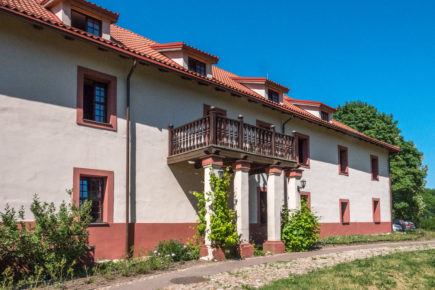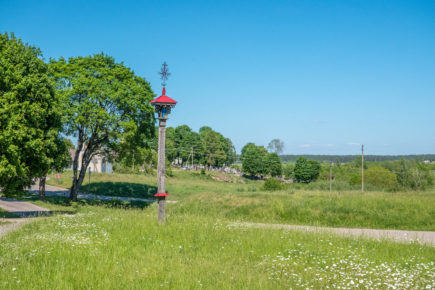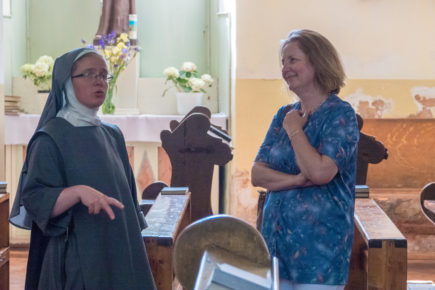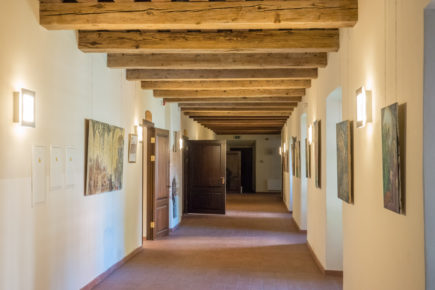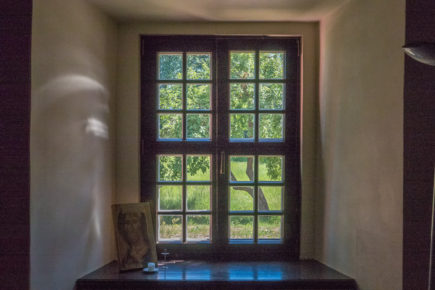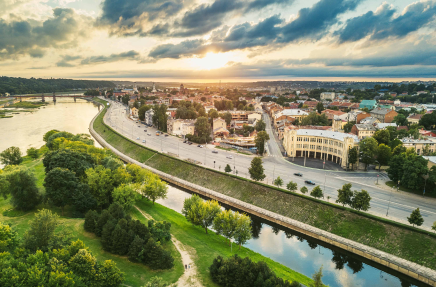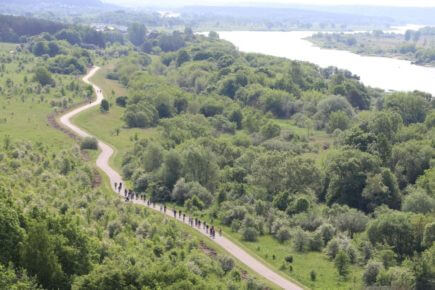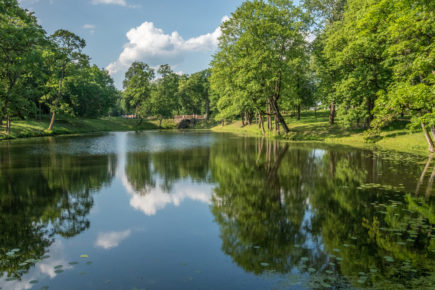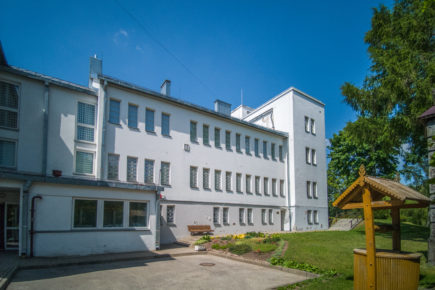Once, the Grand Duke of Lithuania Gediminas, who lived in Kernavė, the capital at the time, decided to go hunting in the forest on the bank of the Neris River. Surrounded by oak groves, he saw a beautiful hill rising above the plains. The Duke was fascinated by the wonderful place and decided to build a castle there, where his son Duke Kęstutis was born. That’s how the castle, which appeared at the beginning of the 14th century, encouraged the rapid development of the town, which is now called Senieji Trakai.
According to archaeologists, people have lived in these areas for millennia. In 1,000 BCE, there was a large settlement next to the lake, which is now a swamp. It is believed that the Senieji Trakai Castle – one of the oldest brick castles in Lithuania – was built there for its strategic location. It was surrounded on all sides by a 40-metre wide ditch and filled with water up to eight-metres deep, and was protected on the outside by a 10-metre high defensive stone wall. This enclosed-type castle could be entered by boat, though a drawbridge was later installed. In around 1350, a child was born in this castle to the Duke of Trakai, Kęstutis and his wife Birute, who later became one of the most famous personalities in the history of Lithuania. The Grand Duchy of Lithuania expanded from the Baltic Sea to the Black Sea during the reign of Duke Vytautas Didysis. The castle was repeatedly attacked and destroyed during the wars with the crusaders. Fateful was the attack of 1391, after which the castle was not rebuilt. It is worth noting that Senieji Trakai was the capital of the Grand Duchy of Lithuania for a brief period (1316-1323). It is believed that Vytautas’ mother Birutė lived here after Kęstutis’ death.
Senieji Trakai Castle stood on a hill surrounded by a deep ditch. Although it witnessed battles with crusaders, nowadays only the chapel pillar, the ensemble of a neo-Gothic church and a rebuilt monastery stand as a reminder of the old castle. The slopes of the mound are decorated with old linden trees from the monastery garden. Next to the former castle site is the village of Senieji Trakai, which has been granted the status of an architectural reserve.
Archaeological excavations have revealed that a fenced-type castle was built in an uninhabited area after extensive earthworks. The wall masonry has shell constructions and well-fired bricks. Bound on the outside of the walls in the Baltic way, tiles were used to cover the roofs.
According to chronicles, Vytautas was not very tall and had energetic facial features. Vytautas radiated self-confidence, energy, vitality, courage and self-esteem. His perception and orientation were remarkable: he was capable of solving multiple problems at once. His sincerity and adherence to righteousness earned him respect among both his own people and strangers. He spent his free time hunting and playing chess and also maintained good relations with merchants. With their help, he acquired great treasures: gold, silver, precious stones, cloths, furs and other jewels, which he then generously shared with others. He surpassed all the rulers of his time with his majesty and cunning mind. Vytautas showed an interest in war items and weapons from a young age, and was particularly interested in new inventions in this field.
Vytautas was fluent in German and Latin. He could have also known Russian, since he participated in many affairs and kinships with Russian dukes. It is also possible that Vytautas knew the Tatar language, as he repeatedly sent letters from his manor written in Tatar. The sciences were also important to the duke, as they could be applied in all facets of life.
After moving to Naujieji Trakai around 1405, Vytautas Didysis moved the Benedictine Monks from Tynec (near Krakow) to his hometown and left it in their care. He built a wooden church and gave the monks land and two lakes. This led to the establishment of one of the first monasteries in Lithuania. The church was rebuilt in 1577 to include a monastery. The wooden church did not survive a fire in 1757. At the end of the 18th century, a brick building was erected as part of the monastery, which in 1845, when the monastery was closed, went to the rectory, and the monks were moved to Nesvyžius. Architect A. Mikulskis rebuilt part of the old monastery into a neo-Gothic church in 1898 and 1899. Today, the old castle site is home to linden trees from the monastery garden, the ensemble of the monastery and the neo-Gothic church rebuilt in the 18th and 19th centuries, and the village of Senieji Trakai is located nearby.
Benedictine Monks in Lithuania are not known to have had any special cultural activity. They lived contemplative monk lives and little is known about their educational activities. Only at the beginning of the 19th century was the primary school at the Senieji Trakai Abbey first mentioned.
Only small fragments of the old Senieji Trakai abbey have survived to the present day, but it is worth admiring the monastery buildings located on the mound, which are reminiscent of dukes and the neo-Gothic church built by architect Apolinaras Mikulskis. The church built at the end of the 19th century illustrates how the tradition of present-day religious life emerges from the prayers of past centuries. The church altars have retained the iconography of the Benedictine style: the large altar of the Crucified on the sides is decorated with sculpture o St. Augustine and St. Benedictine, and the side altars are dedicated to St. Benedict in honour of scholasticism.
For those who want to know where Lithuanian Duke Vytautas was born, the nuns will tell you the story. To stay at the Senieji Trakai Monastery, it is necessary to get in contact with the sister of guests.
Today, the events of Vytautas Didysis’ life are commemorated by nine wayside shrines on the Trakai-Senieji Trakai road.
The first wayside shrine depicts St. Jurgis. In the next one we see Vytautas Didysis as the builder of castles and churches in St. Casimir’s wayside shrine. The wayside shrine dedicated to St. Benedict commemorates the settlement of the Benedictine Monks in Senieji Trakai. The symbol of the arrival of the Karaites in Lithuania is a couple riding a horse, and it is no coincidence that the woman is holding a basket with cucumbers, because it was the Karaites who brought this vegetable to the country from the distant Crimea. The historical Queen of Egypt – the patron of students St. Kotryna Aleksandrietė – gives meaning to Vytautas’ efforts to send young people to study in Western Europe and the first Lithuanian student to study at the University of Krakow: Mykolas from Senieji Trakai. A sculpture of Duke Kęstutis and Birutė greets everyone at the entrance to Senieji Trakai. In their hands, they hold the crown of Vytautas Didysis, which they never received. The Sopulingoji Pieta shrine commemorates the heroic death of Kęstutis in the Krėva Castle. A sculpture of Mary with the Baby stands in the very place of Senieji Trakai’s ancient castle, which is a symbol of motherhood and homeland. The last shrine depicts Duke Vytautas sitting and looking into the distance, holding a sword firmly in one hand and the symbol of the Lithuanian State Vytis in the other.
